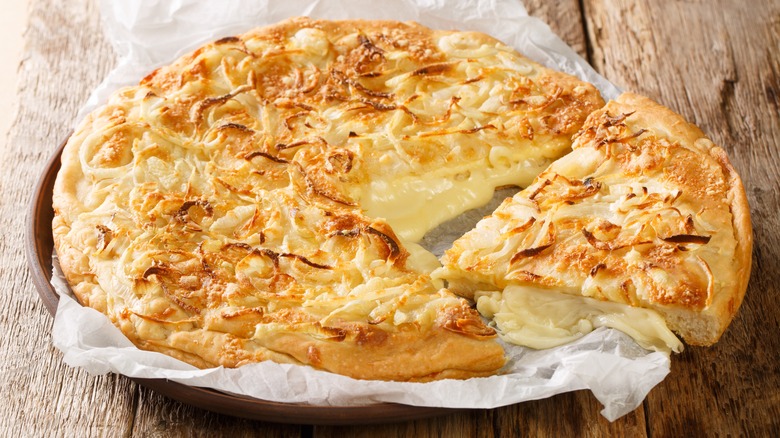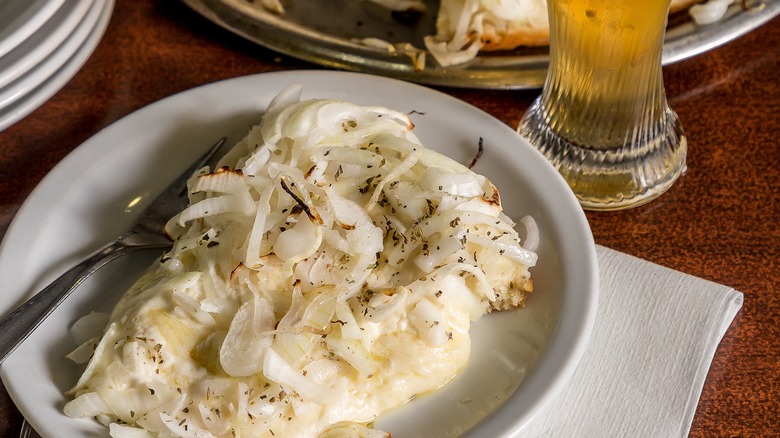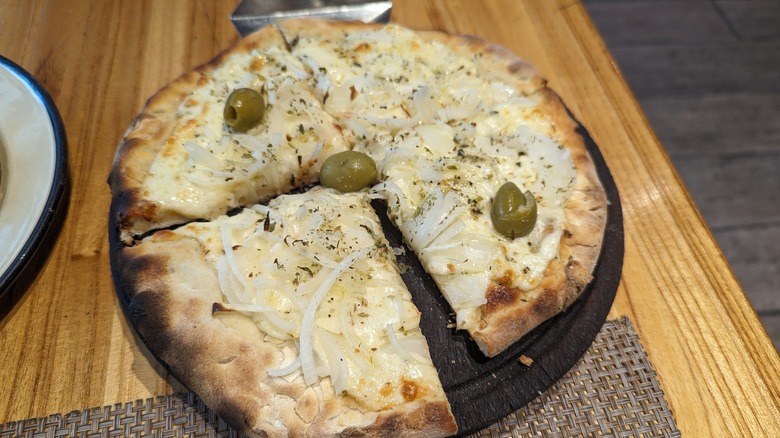What Makes Argentinian Fugazzeta Different From A Standard Pizza Pie?
We are spoiled for choice with all the different types of pizza in the U.S., from thin crust to thick crust, deep dish, and a multitude of toppings in between. Although it originated in Italy, pizza is now loved globally, with a dazzling variety of regional styles to show for it. Take, for example, the Maltese Gozo ftira potato pizza, with its sourdough flatbread base and sheep's milk cheese, or the French-style pissaladière pizza, a tomato-less pie made with onions, olives, and anchovies.
South America also has its own variations, such as Argentina's fugazzeta. One of the main differences that sets it apart from standard American pizza is the kind of dough used, which is essentially focaccia bread. In fact, it's named for the word fügassa, meaning focaccia in the Italian dialect of Genoese. There are a few types of fugazzeta, but two distinctions they all share are that they're not made with tomato sauce, and they are covered with a topping of charred onions.
Fugazzeta evolved from Argentine fugazza, a focaccia made al molde (in a deep pan) that's covered with caramelized onions, and sometimes a sprinkle of oregano and parmesan cheese. Add a layer of mozzarella cheese, and it becomes a fugazzeta. The stuffed version, fugazzeta rellena, sandwiches an extraordinary amount of cheese between two layers of the spongy crust and the obligatory scorched, sweet onions on top. This doubled-up stuffed rendition is what most people think of when referring to fugazzeta.
A century of fugazzeta from Buenos Aires to Miami
Today, fugazzeta is a popular street food enjoyed in Argentina, made even more of a must-have after it was spotlighted in Netflix's 2020 series, "Street Food: Latin America." Its history traces back to 1893, when Don Agustin Banchero immigrated from Genoa to the La Boca neighborhood of Buenos Aires and opened the Riachuelo bakery with his son Juan, where he first served his version of Italian focaccia with an Argentinian twist. In 1932, Juan and his sons Antonio and Tito opened Pizzeria Banchero, which offered Don Agustin's fugazza, plus Juan's own invention, the fugazza con queso, which subsequently birthed the stuffed fugazzeta.
More than 90 years later, the original Banchero Pizzeria is still family-run and open for business. The restaurant also has a U.S. satellite location in Miami, where the Florida outpost's claim to fame is that its fugazza is Argentinian soccer legend Lionel "Leo" Messi's favorite pizza.
Another Buenos Aires spot known for its fugazzeta rellena is Pizzeria La Mezzetta. Opened in 1939 as a direct competitor of Banchero's, it's now considered one of the best spots in the world to eat the stuffed cheese and onion delicacy. Since it was featured in the Netflix special as the go-to spot for fugazzeta, it's not uncommon to see lines of hungry patrons form outside the restaurant and snake down the block.
The fillings and toppings on this massive stuffed pizza
Fugazzeta rellena comes stuffed with a seriously intense amount of cheese. Imagine a solid inch or more of melty, gooey, stretchy mozzarella that oozes out from between springy layers of crust and flawlessly cooked onions. The onions aren't skimped on either, usually piled on generously to cover the pizza entirely, and baked until they're just starting to turn crispy and slightly burned at the edges.
An entire pie from La Mezzetta is a veritable cheese bomb. Along with the mozzarella, fugazzeta can also be made with provolone and finished with a grating of either Pecorino Romano or parmesan.
Aside from the classic mozzarella recipe, there are versions that are stuffed with even more ingredients. Fugazzeta de verdura is made with the addition of spinach and other vegetables, and fugazzeta con jamón gets filled with ham. While not traditional, you can also sometimes find it topped with olives, roasted red peppers, or tomatoes.



